Carbonara
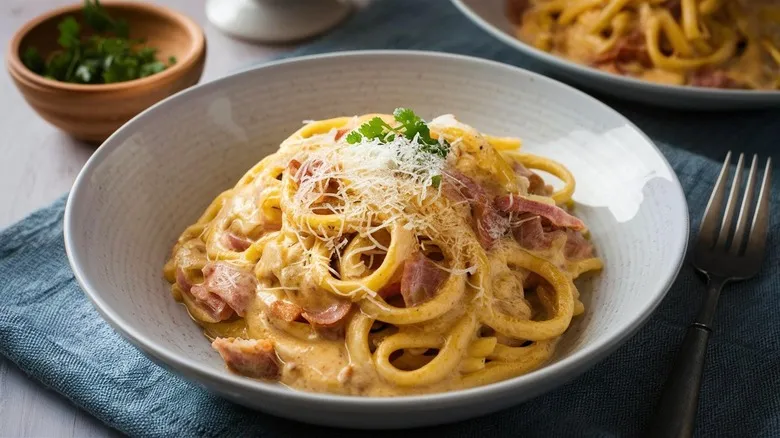
Few dishes embody comfort food quite like a bowl of carbonara pasta. A traditional carbonara recipe features just a handful of ingredients: pasta, raw eggs, guanciale (cured pork cheek), Pecorino or Parmesan cheese, salt, and black pepper. While the dish is often associated with Rome and the Lazio region of Italy, its true origins remain a topic of lively debate. Various theories exist regarding how this creamy, cheesy pasta dish came to be.
According to La Cucina Italiana, the name "carbonara" is derived from the Italian word "carbonaro," meaning "charcoal burner." This has led many to theorize that the dish may have been created by Italian charcoal workers. Another popular theory suggests that American soldiers stationed in Italy at the end of World War II invented the dish by mixing their rations of bacon and eggs with local cheese and pasta. Additionally, some believe that pasta carbonara may be an adaptation of a dish known as pasta cacio e uova, which consists of pasta tossed with eggs, cheese, and lard.
Puttanesca
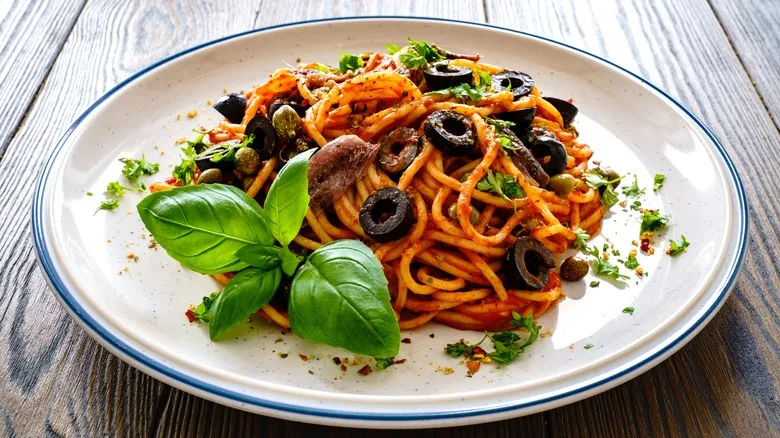
If you're seeking a simple and quick way to elevate store-bought tomato sauce for a pasta dish, puttanesca is an excellent choice. This lively dish features pasta coated in a sauce made from tomatoes, garlic, olives, capers, chili flakes, and fresh herbs like parsley and oregano. Some variations also incorporate anchovies. It's aromatic and bursting with briny, spicy, umami flavors. However, it's worth noting that some people believe this pasta dish has a provocative history. Pasta puttanesca loosely translates to "in the style of prostitutes."
Most historians agree that pasta alla puttanesca originated in Naples and gained popularity around the 1960s. The reason behind its name is still debated. Some suggest the dish was created in brothels as a quick meal for the women to enjoy between clients. Another theory posits that a man named Sandro Petti invented the dish for hungry friends who urged him to whip up any old "puttanata," an Italian slang term. According to Gambero Rossi, Petti later renamed it puttanesca to make it a bit less crude.
Beef Stroganoff
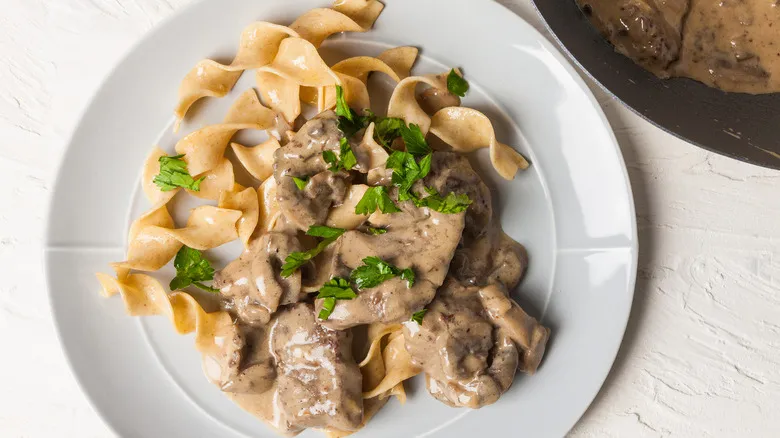
Hearty, rich, and flavorful, beef Stroganoff is an ideal dish for a chilly winter evening. A classic recipe typically features sautéed strips of beef, onions, and mushrooms enveloped in a creamy sour sauce. Gourmet variations may incorporate ingredients like cognac, Worcestershire sauce, and Dijon mustard. This stew-like dish is commonly served over mashed potatoes, rice, or egg noodles. Originating from Russia, it is named after the noble Stroganoff family, though there is some debate about which family member the dish is most closely associated with.
The most widely accepted theory suggests that beef Stroganoff was developed for Count Alexander Grigorievich Stroganoff. In the 19th century, the Count hosted "open table" dinners at his residence in Odessa, where many believe his chef crafted the dish for its simplicity, broad appeal, and ease of serving. Another popular narrative claims that an older member of the Stroganoff family had difficulty chewing, prompting the chef to create a softer dish that was gentler on the Count's teeth compared to tougher cuts of meat. Additionally, some suggest that the dish bears French influences due to the French chefs employed by the Stroganoff family.
Fettuccine Alfredo
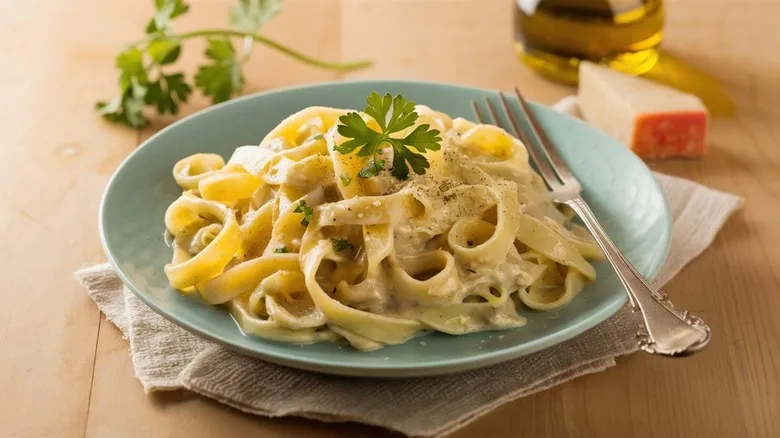
It's clear why fettuccine Alfredo is a favorite at numerous Italian eateries. This rich pasta dish is incredibly easy to prepare yet indulgently delicious. A traditional fettuccine Alfredo consists of fresh fettuccine noodles combined with butter and Parmigiano Reggiano cheese. Popular variations often include cream, parsley, vegetables like mushrooms, and proteins such as chicken. However, many enthusiasts insist that the only place to experience a truly authentic fettuccine Alfredo is at its origin in Rome.
The dish was invented by a Roman chef named Alfredo Di Lelio. In 1914, after his wife had just given birth to their son and was feeling weak, he wanted to prepare something hearty yet easy to consume. He created the buttery, cheesy pasta dish, which she adored so much that he decided to add it to the menu. When Hollywood stars Mary Pickford and Douglas Fairbanks tasted the dish during their vacation in Rome, they were so impressed that they shared their experience, leading to its popularity in the United States. You can savor the original recipe at Ristorante Alfredo alla Scrofa, where it was first made, or at Il Vero Alfredo, which is run by Di Lelio's family.
Mac and cheese
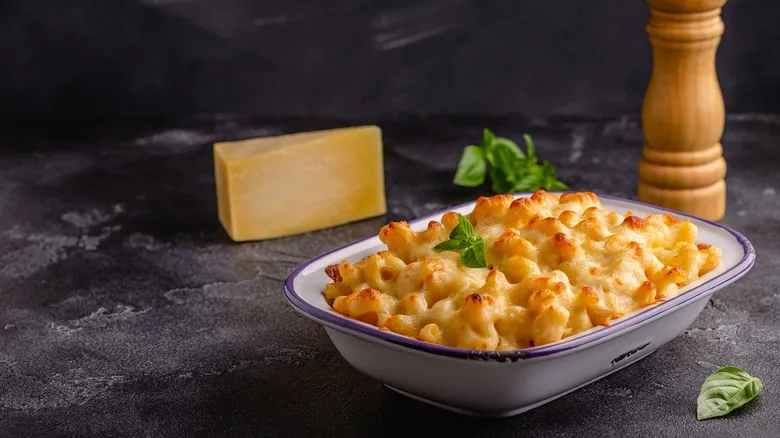
When you think of quintessential American comfort food, macaroni and cheese likely springs to mind. You might recall enjoying boxed mac and cheese featuring that bright orange powdered cheese during your childhood. Or, if you were fortunate, perhaps a family member prepared it from scratch using real cheese, butter, and milk. This dish is a beloved staple at potlucks, celebrations, and barbecues, evoking cherished memories of family meals and gatherings for many. But just how American is mac and cheese?
Italians have been pairing pasta with cheese for centuries, so it’s not surprising that one of the earliest recipes for mac and cheese can be traced back to a 13th-century Italian cookbook. The journey of this dish to America is particularly fascinating. In 1784, Thomas Jefferson was appointed Minister to France and took his enslaved chef, James Hemings, with him to Paris. During his time in Europe, Jefferson developed a fondness for macaroni and cheese, prompting Hemings to perfect the recipe and bring it back to the United States. The introduction of dried pasta and processed cheese in the early 20th century further propelled the popularity of mac and cheese.
Strozzapreti
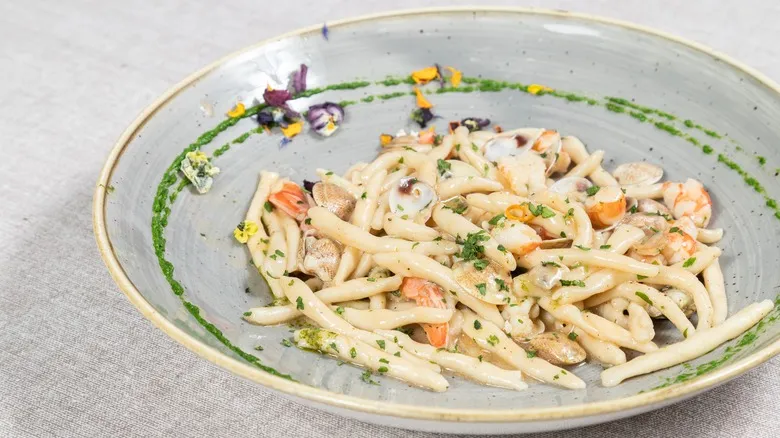
Many chefs will assert that there is a significant distinction between machine-made and handmade pasta. Handcrafted pasta often boasts a fresher taste and a superior texture that better absorbs sauce. If you're seeking a simple pasta to prepare by hand, strozzapreti should definitely be on your list. The process is straightforward: roll out your pasta dough, cut it into strips, and twist those strips. This twisted pasta is ideal for coating in cream sauce, mixing with meat and vegetables, or generously topping with ragu. Interestingly, the name also hints at a more ominous connotation.
Strozzapreti, also known as strangolapreti, translates to "priest choker" or "priest strangler." There are several theories regarding the origins of this pasta's grim name. One suggests that Catholic priests in the Emilia Romagna region of Italy were notorious for their greed and tyranny. In retaliation, disgruntled housewives crafted this twisted pasta and cursed it, wishing ill upon any priests who dared to consume it. Some believe that the twisting technique used to make the pasta symbolizes the act of strangling priests, while others argue that the pasta resembles the collars worn by clergy.
Spaghetti and meatballs
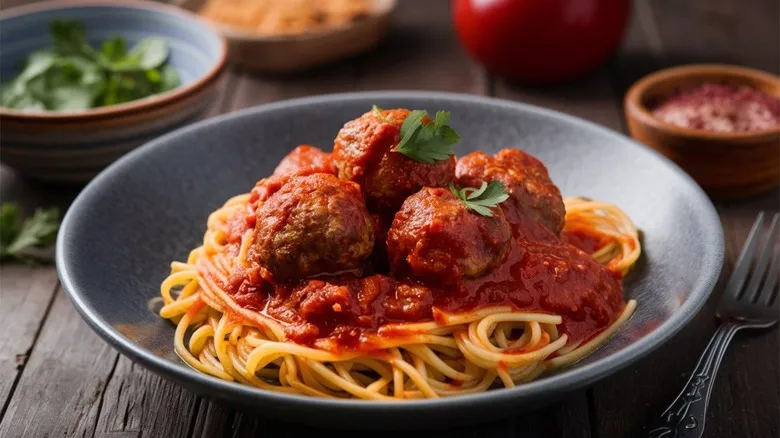
For many, nothing embodies Italian cuisine quite like spaghetti and meatballs. This dish features classic Italian elements such as pasta, tomato sauce, meat, and Parmesan cheese. However, you might be surprised to learn that spaghetti and meatballs is just one of many so-called "Italian" dishes that actually originated in the United States. While it has gained immense popularity around the globe, it is not commonly found in Italy, except in some restaurants that cater to tourists.
That said, Italians do enjoy meatballs and spaghetti with tomato sauce, but they typically don’t combine the two. In Italy, meatballs are known as polpette and can be made from a variety of ingredients, including beef, turkey, and fish. They are often served on their own or accompanied by a salad. The creation of spaghetti and meatballs arose from the combination of ingredients that Italian immigrants in 19th and 20th-century America could easily access and afford, such as ground meat, canned tomato sauce, and dried pasta.
Pasta primavera
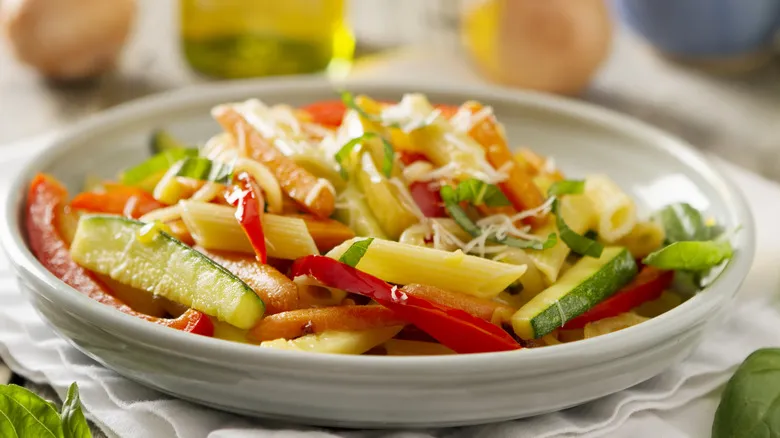
Pasta primavera certainly evokes an Italian vibe. The term "primavera" translates to "spring" in Italian, reflecting the seasonal vegetables featured in the dish, such as peas, zucchini, and asparagus. These vegetables are combined with butter, cream, and cheese to create a rich sauce that unifies the flavors. The dish is vibrant, creamy, and offers a delightful crunch from the veggies and a sprinkle of pine nuts. However, it’s important to note that it is not actually Italian. Pasta primavera originated in Nova Scotia, Canada.
According to legend, chefs Sirrio Maccioni and Jean Vergnes from Le Cirque restaurant in New York were on vacation at a property in Nova Scotia with food writers from the New York Times. One day, they crafted a meal using leftovers they discovered in the fridge. They named the dish spaghetti primavera, and it quickly became popular. Although Vergnes was hesitant to add it to the menu at Le Cirque, Maccioni decided to feature it as a special. This decision generated significant excitement, and soon the dish was all the rage. Craig Claiborne of the New York Times even referred to it as "By far, the most talked-about dish in Manhattan."
Cacio e pepe
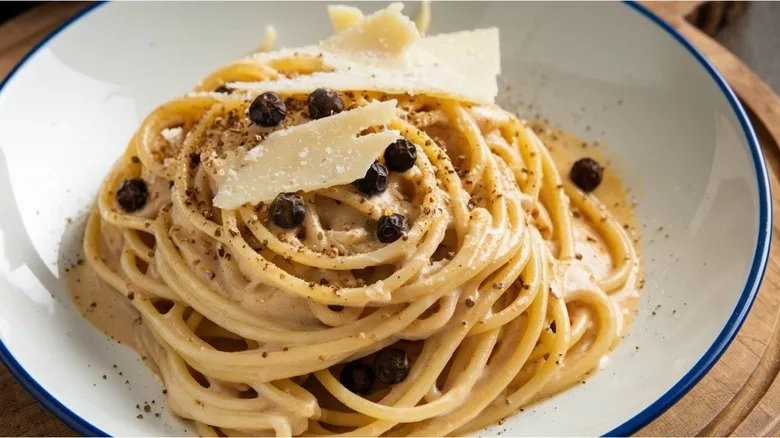
Often, it's the simplest dishes that leave the most lasting impression. Such is the case with cacio e pepe, an incredibly flavorful pasta made with just three ingredients. Essentially, it consists of thin pasta, like spaghetti, combined with Pecorino cheese and black pepper. A splash of reserved pasta water adds a creamy texture to the dish. This classic Roman recipe is rich in history.
Cacio e pepe, which means "cheese and pepper," was a fundamental meal for ancient shepherds in Italy's Apennine Mountains. As they herded their livestock, these shepherds required sustenance that was durable, warming, and energy-boosting. Their solution was dried pasta, hard Pecorino cheese, and black pepper. According to La Cucina Italiana, this dish later became a favorite in Roman taverns, as the dryness of the pasta encouraged patrons to drink more.
There are numerous variations of cacio e pepe. Some prefer using bucatini or other long pasta shapes, while others incorporate olive oil or butter to prevent clumping. However, traditionalists argue that simplicity is key when it comes to this beloved dish.
Lasagna
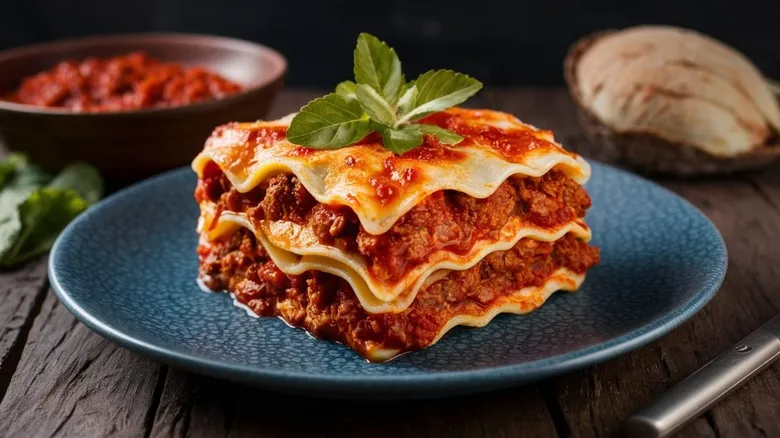
It's clear why lasagna is a favorite for so many. This classic Italian dish showcases delicate pasta sheets layered with rich meat sauce (or vegetables for those who prefer a meatless option) and melty cheese. Baked to perfection until it’s bubbling and golden on top, lasagna delivers a delightful combination of textures and flavors. Another reason for its popularity is its versatility. From its origins in Greece — yes, that's correct — it has evolved through numerous variations and can still be made in countless ways today.
Like many pasta dishes on this list, lasagna didn't actually originate in the country you might expect. It was likely inspired by a Greek dish called laganon, which featured layers of pasta dough combined with other ingredients like fish. The ancient Romans brought this culinary technique back to Italy, where it transformed into lasagne. Depending on the region in Italy, the dish can vary significantly. For instance, in Bologna, it often includes béchamel sauce, while in southern Italy, it’s commonly made with cheeses such as ricotta and mozzarella. With this in mind, there's no need to stress about making mistakes with lasagna. Instead, feel free to experiment and add your own creative touches.
Italian wedding soup

Despite its name, Italian wedding soup may lead you to believe it was created for a lavish celebration. In reality, this soup has its roots in humble peasant fare rather than an extravagant wedding dish. The version you might recognize in the United States, featuring meatballs, pasta, spinach, Parmesan, and herbs in a flavorful broth, differs significantly from its original form. Additionally, it wasn't named after a wedding ceremony.
In Italy, the soup is called minestra maritata, which means "married soup." This name refers to the combination of vegetables and meat. According to America Domani, the dish originated in southern Italy around the 15th century as a winter meal, utilizing hardy vegetables that could be harvested year-round and leftover scraps from the annual pig slaughter. The broth was typically made by simmering pork bones. When Italian immigrants arrived in the United States, they modified the recipe to include more accessible ingredients like ground beef, spinach, and pasta.
Spaghetti bolognese
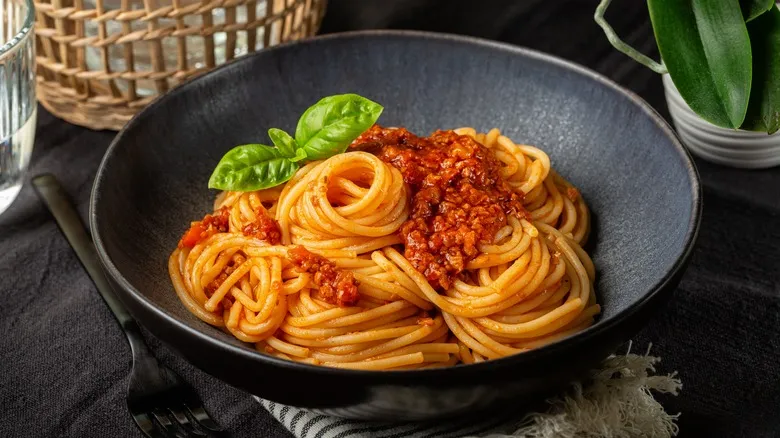
When people crave a comforting and familiar Italian pasta dish, they often reach for spaghetti bolognese. This traditional "spag bol" typically includes diced onions, carrots, and celery simmered in a rich tomato sauce with ground beef or pork. Some enhance it with ingredients like bacon, oregano, and cream. While it is widely regarded as an Italian classic, you won't find it on many menus in Italy. This is because the sauce is actually known as ragu alla Bolognese, and it is seldom paired with spaghetti.
The earliest references to ragu alla Bolognese can be traced back to Alberto Alvisi, who served as the chef for the Cardinal of Imola in the 18th century. Although the dish has evolved over the years, many agree that certain key components are essential to its authenticity. The Accademia Italiana della Cucina stipulates that it must be prepared with ground beef, pancetta, tomatoes, carrots, celery, onions, and wine. While you can add chicken livers or porcini mushrooms for extra flavor, bacon and garlic are strictly prohibited. Additionally, many purists insist that it should be served with fresh tagliatelle.
Tortellini
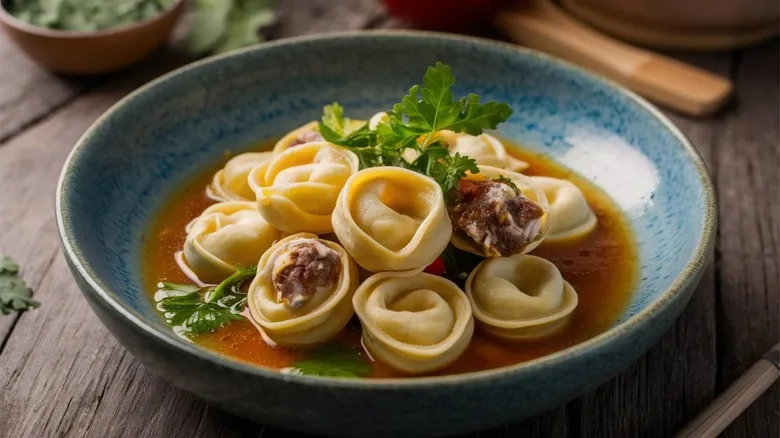
Italy boasts a vast array of pasta varieties, but only one has a tale that intertwines a peeping Tom and a goddess. The town of Castelfranco Emilia proudly claims to be the birthplace of tortellini. According to local legend, the dish was inspired by the goddess Venus, who once passed through the town and stayed at a nearby inn. The innkeeper, curious about the goddess, peeked through the keyhole and was struck with the idea to craft a pasta shaped like her navel.
Regardless of whether you buy into the legend of tortellini's origins, there's no denying that this pasta dish is truly delightful. Flat egg noodles are rolled out thin, cut into squares, and filled with a mixture that often includes meat and cheese. The pasta is then folded around the filling to create circular parcels. In the Emilia-Romagna region, where tortellini has been enjoyed since the 12th century, it is typically served in broth. However, you can also find tortellini sautéed in butter and accompanied by sauce, or even sweet versions filled with cream and sprinkled with sugar.
Cincinnati chili
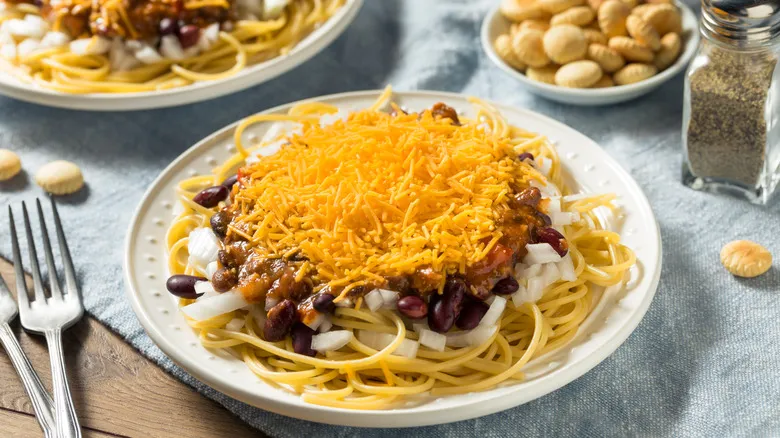
To those unfamiliar with Cincinnati, the idea of combining chili with pasta and garnishing it with beans, onions, and cheese may seem unusual. Nevertheless, residents take immense pride in this dish, considering it as deserving of acclaim as Chicago-style hot dogs or hoagies. Similar to these well-known regional specialties, Cincinnati chili has its roots in the creativity of immigrants who adapted the flavors of their homeland to suit American palates.
In 1920, brothers John and Tom Kiradjieff emigrated from Macedonia to the United States. A few years later, they established the Empress Chili Parlor, coinciding with the rising popularity of chili parlors across the country. However, the brothers did not offer traditional Texas-style chili. Instead, they infused their version with Mediterranean spices such as nutmeg, clove, and cinnamon. The local community embraced their creation, leading to popular variations like serving chili over spaghetti and the "five-way" option, which includes spaghetti, chili, diced onions, kidney beans, and shredded cheddar cheese. While oyster crackers are optional, they are highly recommended.
Recommended

Dressing Vs Stuffing: The Differences You Need To Know
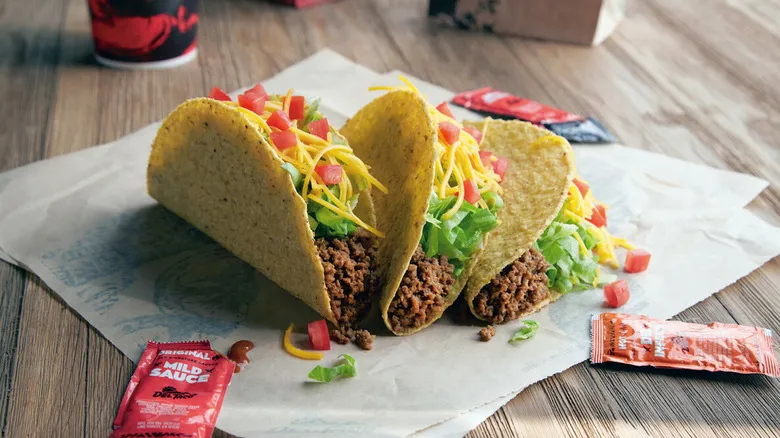
Here's What Del Taco Prices Looked Like On Opening Day In 1964

19 Weird State Food Laws You Didn't Know Existed

What Sets Old World Pepperoni Apart From The Rest
Next up

